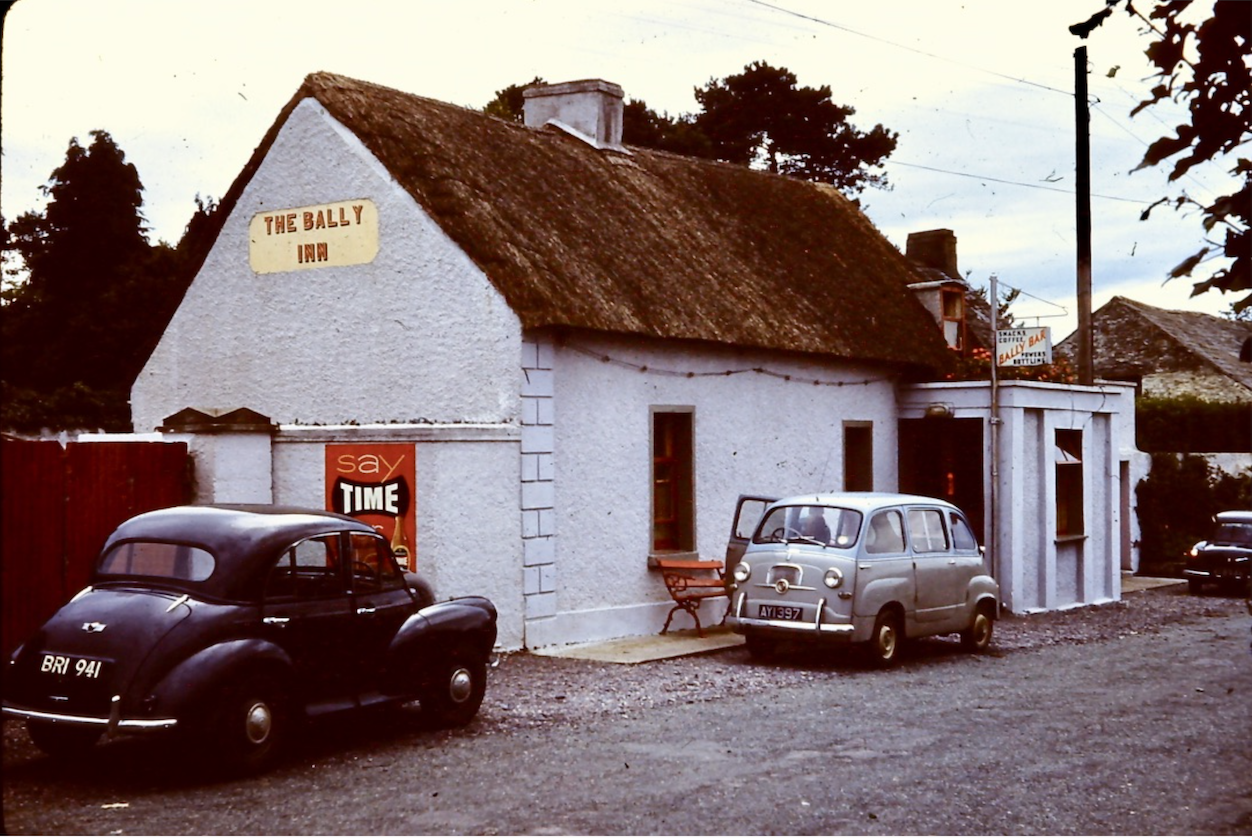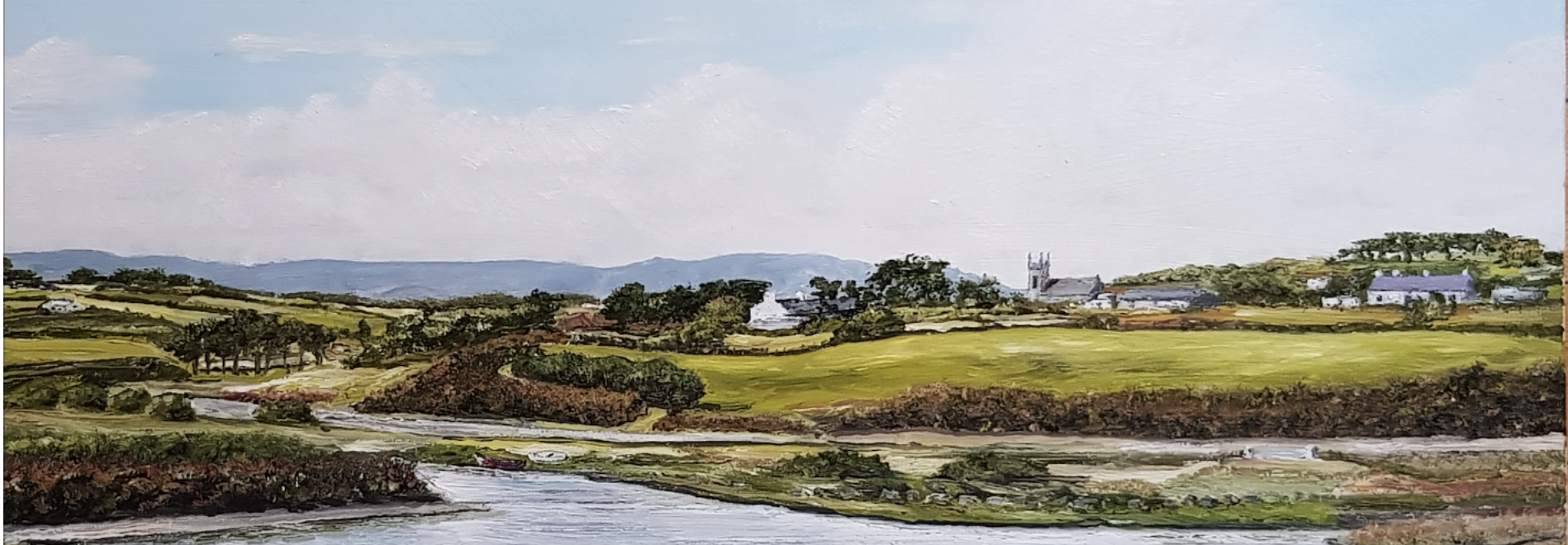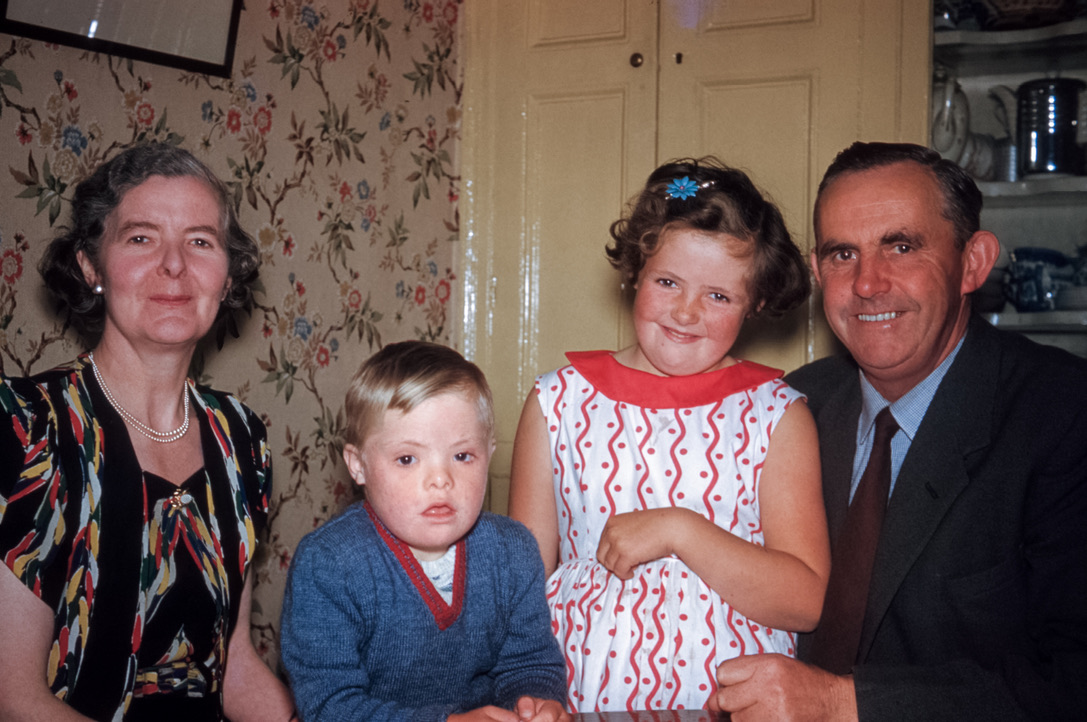EPISODE 428 AIDAN COFFEY..IRISH PROFESSOR OF BIOLOGICAL SCIENCE AND.IRISH PAINTER SENDS A PERSONAL
alan skeoch
Sept. 2021
NICE THINGS DO HAPPEN EVEN IN OUR VERY TROUBLED WORLD.
Right now we are living in a very troubled world. The troubles need not be mentioned here because this story
is about a little village on the south coast of Ireland where I suddenly found myself in 1960. A village that burned
itself so deep into my psyche that I remember every event as if they happened yesterday. And that was 62 years ago.
Earlier in these Episodes I told many stories about Bonmahon and the mysterious abandoned copper mine of Knockmahon whose
abandoned tower broods over the village.
Take a moment and study the painting by Aidan Coffey below. Then read Aidan’s very flattering email message.

Hello Alan,
I’m from Ballylaneen, near Bunmahon, County Waterford. I was fascinated with your photographs from the Bunmahon area from 1960 on your website. I’ve been travelling through your writings about your time there, downloading photos with people in them, and I’ve been getting my mother (now aged 83) to help identify them. I knew Mrs Kennedy, who you mention and Sis Kirwan of Kirwans pub, long deceased. As well as my interest in local history, I have painted many scenes from around County Waterford. I have attached a few of my efforts here, and you may recognise them. I still travel to County Waterford once a week and take my mother for a drive around all those areas you would have been familiar with, photographing as I go with paintings in mind.
I look at your photographs as precious documents of local history. Thank you for taking them (as such a young person in 1960) and thinking to post them on the internet. The attached photo you took of the Bally Inn in Ballylaneen in 1960 is one of my favourites. I remember it exactly like that as a child. The building got renovated in the early 70s and changed a bit, though it still does have the thatch today: it closed recently and is now for sale. I worked there in the bar as a 14-year-old in 1976 – and painted a picture of it in 1981 for the then owner. That’s your car, the unusual one in front? Your photos of the little isolated church and the thatched cottages are also interesting (the area is called Faugheen, a mile from Bunmahon). The cottages have now disappeared, but the little church is still well maintained. I wondered do you have other County Waterford photos not yet posted on your website? I would like to see them and get persons in them identified while my mother’s memory is still good.
I won’t write more here now in case you don’t get this email.
Kind regards
Aidan Coffey
Address etc, etc
Professor Aidan Coffey, BSc, MA, PhD, DSc (NUI)
Dept Biological Sciences (CREATE),
Munster Technological University,
Cork, T12 P928, Ireland.
Phone 353-21-4335486

Email Disclaimer:

Ah yes, John Hogan and I spent one evening in the Ballyaneen pub … frothy draughts of Guinness
coupled with spontaneous outbursts of song. Not done for our benefit. Singing and drinking for the pure joy of
people getting together in a small pub in a small village on the western edge of the County Waterford. Folk songs.
Good time songs mostly …’ When Irish Eyes are Smiling’ —those kinds of songs but more local than that. “Danny
Boy” kind of music with a twist. We were told about the music at this pub by one of our employees. Early in our
job I hired most of the men and boys in the village of Bonmahon. Paid them one pound a day plus a pack of Wilde
Woodbine cigarettes as a kind of tip. They needed the work. Our boss back in Canada wondered why we needed
so many employees…i.e. about ten men. I did not mention that need was the reason. It was partly so. But there were
jobs to do. Deep trenches had to be dug in hope that a copper bloom would be found on the bed rock, A boy had
to guard our motor generator form marauding pigs I needed a man to lift me over the stone fences that bound the tiny Irish fields.
A couple of line cutting survey crews had to be trained, Lots of reasons. Good public relations. Intead of being
regarded as intruders we wanted to be loved as pseudo-Irish.
WHAT WERE WE DOING?
Just a quick explanation for those who did not read the Earlier Episodes. I was a second year student at the University of Toronto
who has been trained in the operation of a Turam Electro-Magnetic Mining survey system on a job in western Alaska the previous
summer. Good luck. So I was sent to Ireland in the summer of 1960. I wanted to do a good job for my Canadian boss,
Dr. Norman Paterson who trusted me. We were a team of three. Dr. John Stam, a geophysicist…John Hogan, a geologist
with Denison Mines and me, a young 22 year old venturing into the world like Voltaire’s Candide. I was designated as a
‘Field Man’. My job was to get the magnetic readings for Dr. Stam to interpret and John Hogan to oversee as the
contractor’s rep. Let’s not overstate my role. I was the grunt…the guy who got his hands dirty. Or better stated
I was the guy who had to pick the ticks off his body after work each day. The grunt. As a result I got the closest to
the Irish who lived in the village. And I still remember them. Even the village priest got involved, or so I thought, when
the boys pointed him out standing on the road sometimes watching.
Our project held the promise of reopening the abandoned Knockmahon copper mine last open in the 1870’s
Everyone hoped we would do that. I wish we had been successful but we were not.

Here is Aidan Coffey’s painting of the Mahon River spilling into the Atlantic Ocean. In the distance is the Catholic Church
where i attended Sunday Mass and tried to avoid the Holy Water that the lads tried to hit me with knowing I was a
Presbyterian. Bridey, our maid, ripped the covers off my bed on my first Sunday and announced it was time for
Mass. Got to really enjoy being part of this tiny village community.

This is Bonmahon as it appeared in 1960 and as it appears today. See the house on the curve. We rented the
top floor in 1960. Mrs. Kennedy and her family lived below us somewhere in the rambling building part of which was
the only store in Bonmahon. Mrs. Kennedy was a powerful woman who kept a close eye on us because a previous
group of Canadian mining men had raised hell in the village. She grew to like us because, initially, we played pinochle at night
Even our drinking was restrained. Down towards the sea there are two buildings …two pubs.
The pub on the left was the Anglican (Church of Ireland) pub and the pub almost hidden by trees is Kirwin’s pub
which was the watering hole for the Catholics who were the great majority. We drank in Kirwin’s with our employees.
The Mahon River weaves its way to the sea (top left) and far in the distance stand the old mine workings. The black
cliffs were not black…coloured with mineral stains. Here and there along the cliffs were old adits…horizontal mine
holes which Barney Dwan, my main man, took me on adventures many evenings. Crawling on our stomachs at times.
Doing the kind of things that 22 year old single males adore.

This is the Kennedy family. Wonderful people. I got to know their son Gerald best of all because he tended to follow me around quite
a bit along with his guardian, an aged and long suffering Labrador dog that Gerald sometimes tried to ride.

Here are some of our employees flanked by Dr. John Stam on the left and John Hogan on the right. The young man in the middle
in the checked shirt is Barney Dwan who became a close friend leading me into the bowels of the earth in evening explorations. I called
him Bandy for a long time because the Waterford accent was so different. That made everyone laugh each time I said it. By the end
of the job they were all calling him Bandy.
One curious thing about Bonmahon was the fact that no one was the descendent of a miner even though there were once over 2,000 people
living here in the 19th century. Miners are nomadic because mines are finite. Once the ore is gone, the miners leave. Many of the
Bonmahon 19th century miners came from Cornwall and moved on in mass to mines in the Unied States. Another curious fact was
that many were Methodists. The Catholic Church was once Methodist I seem to remember discovering. The presence of Methodists
played hell with the numerous pubs that were once present.
Hell is a word that should not be forgotten. Mining in Bonmahon was the closest thing to hell I have experienced. Low pay Dirty dangerous
work in the darkness of the earth with just candles and little else to light the way. Before closing the Knockmahon copper mine had
tunnelled under the Atlantic Ocean. Think about that. Think about climbing up and down long wooden ladders in a darkness so black
that sight was useless.

The publicists of County Waterford now call the region around Bonmahon “The Copper Coast” in the hopes that it will become
a mecca for tourists. Lucky for Bonmahon the skeletal remains of the Knockmahon mine still towers over the community giving
the area a charm not to be forgotten. I remember the open main shaft here because it had been used as a garage dump with
all kinds of treasures particularly a whole truckload of glass milk bottles. Seems the milk was being packaged differently or
the bottle style was obsolete. I never had the nerve to crawl down that sloping mass of waste in search of treasure.
That is Dr. Stam and John Hogan going for a stroll along the Copper Coast Highway.
MUCH MORE TO COME…BUT FIRSST WE NEED TO CONSIDER
‘THE QUIET MAN’…REMEMBER THE MOVIE?
alan skeoch
Sept. 2021
